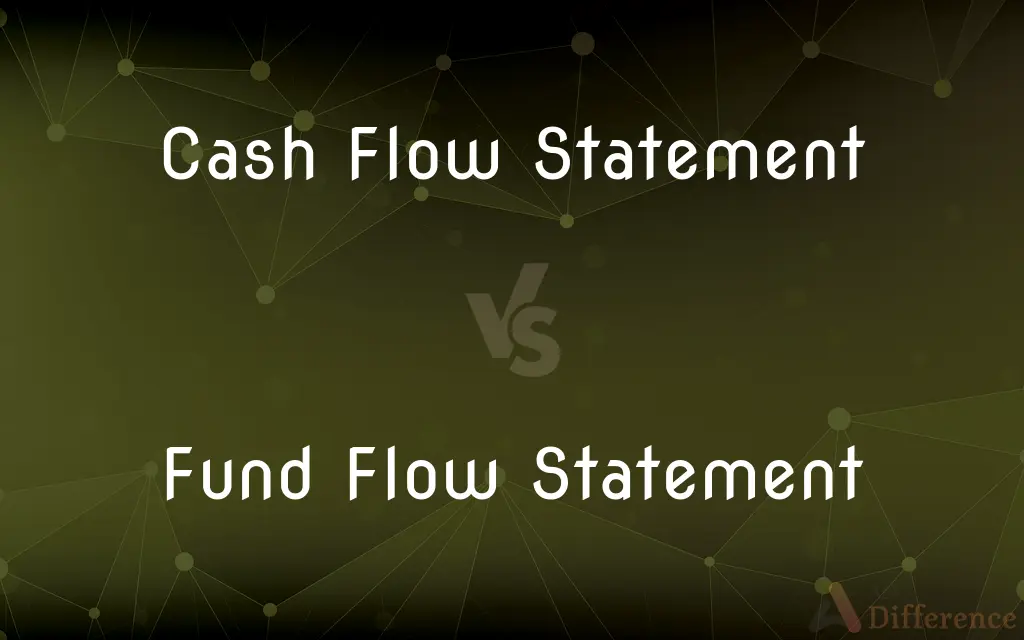Cash Flow Statement vs. Fund Flow Statement — What's the Difference?
Edited by Tayyaba Rehman — By Fiza Rafique — Published on December 1, 2023
The Cash Flow Statement tracks cash inflows and outflows, while the Fund Flow Statement records changes in working capital.

Difference Between Cash Flow Statement and Fund Flow Statement
Table of Contents
ADVERTISEMENT
Key Differences
The Cash Flow Statement gives a detailed account of cash inflows and outflows over a period, focusing on operational, investing, and financing activities. In contrast, the Fund Flow Statement provides insights into changes in working capital, highlighting sources and applications of funds.
While the Cash Flow Statement revolves around liquidity and shows how cash positions have altered, the Fund Flow Statement provides a broader perspective on financial health by including non-cash items.
Both statements serve different analytical purposes. The Cash Flow Statement helps stakeholders understand liquidity aspects of a company, whereas the Fund Flow Statement aids in comprehending how funds moved within the business.
Financial analysts might refer to the Cash Flow Statement to assess a company's ability to generate positive cash flow and meet obligations. Simultaneously, they'd look at the Fund Flow Statement to see changes in assets and liabilities, providing insights into overall financial strategy.
In sum, the Cash Flow Statement gives a narrow, liquid perspective, honing in on cash activities. On the other hand, the Fund Flow Statement offers a wider viewpoint, delving into working capital changes and financial adjustments.
ADVERTISEMENT
Comparison Chart
Focus
Cash inflows and outflows
Changes in working capital
Components
Operational, Investing, Financing activities
Sources and applications of funds
Perspective
Liquidity
Overall financial health
Analytical Purpose
Assesses company's ability to generate positive cash flow and meet debts
Provides insights into financial strategy and changes in assets/liabilities
Inclusion of Non-Cash Items
No
Yes
Compare with Definitions
Cash Flow Statement
Summary of cash inflows and outflows.
Based on the Cash Flow Statement, the company maintained liquidity.
Fund Flow Statement
Statement revealing shifts in assets and liabilities.
A surge in working capital was evident on the Fund Flow Statement.
Cash Flow Statement
Analysis of company's liquidity over time.
The drop in financing activities on the Cash Flow Statement raised concerns.
Fund Flow Statement
Breakdown of financial strategy over time.
The Fund Flow Statement revealed a focus on reducing debts.
Cash Flow Statement
A financial report tracking cash movement.
The Cash Flow Statement showed a significant outflow from investing activities.
Fund Flow Statement
Analysis of sources and uses of funds.
The Fund Flow Statement showed funds raised through equity.
Cash Flow Statement
A reflection of cash position changes.
The Cash Flow Statement displayed a net cash increase for the quarter.
Fund Flow Statement
Overview of financial adjustments.
The Fund Flow Statement indicated a reduction in short-term liabilities.
Cash Flow Statement
Statement detailing cash transactions.
The Cash Flow Statement revealed a surplus from operational activities.
Fund Flow Statement
A report detailing working capital changes.
The Fund Flow Statement highlighted an increase in long-term assets.
Common Curiosities
Can non-cash items be found in a Cash Flow Statement?
No, the Cash Flow Statement solely focuses on cash transactions.
Which statement helps assess liquidity, Cash Flow Statement or Fund Flow Statement?
The Cash Flow Statement helps assess liquidity.
What does the Fund Flow Statement primarily showcase?
Changes in working capital, highlighting sources and applications of funds.
What is the primary objective of the Cash Flow Statement?
To detail cash inflows and outflows from operational, investing, and financing activities.
Are equity transactions reflected in the Cash Flow Statement?
Yes, under the financing activities section.
Which statement would be more useful for short-term liquidity analysis?
The Cash Flow Statement.
Can a company have a positive Fund Flow Statement but negative Cash Flow Statement?
Yes, due to non-cash adjustments and working capital changes.
Can borrowings be traced in the Fund Flow Statement?
Yes, as a source of funds.
Is depreciation included in the Fund Flow Statement?
Yes, it's considered as it impacts working capital.
How does the Cash Flow Statement categorize transactions?
Into operational, investing, and financing activities.
Which statement provides a broader perspective on financial health?
The Fund Flow Statement offers a more comprehensive view of financial health.
Which statement provides insights into a company's long-term financial strategy?
The Fund Flow Statement.
Which statement might be more complex to prepare?
The complexity depends on company transactions, but the Fund Flow Statement might require a deeper analysis of working capital changes.
What would be the impact of issuing shares on the Fund Flow Statement?
It would be shown as a source of funds.
Is purchase of machinery reflected in the Cash Flow Statement?
Yes, under investing activities.
Share Your Discovery

Previous Comparison
Strategic Planning vs. Strategic Management
Next Comparison
Northern Inuit vs. HuskyAuthor Spotlight
Written by
Fiza RafiqueFiza Rafique is a skilled content writer at AskDifference.com, where she meticulously refines and enhances written pieces. Drawing from her vast editorial expertise, Fiza ensures clarity, accuracy, and precision in every article. Passionate about language, she continually seeks to elevate the quality of content for readers worldwide.
Edited by
Tayyaba RehmanTayyaba Rehman is a distinguished writer, currently serving as a primary contributor to askdifference.com. As a researcher in semantics and etymology, Tayyaba's passion for the complexity of languages and their distinctions has found a perfect home on the platform. Tayyaba delves into the intricacies of language, distinguishing between commonly confused words and phrases, thereby providing clarity for readers worldwide.













































